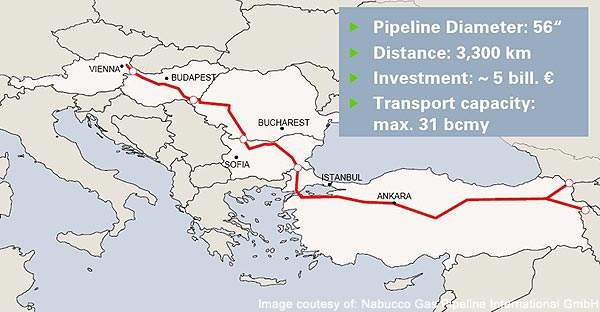
The Nabucco pipeline is a new gas pipeline (56in) proposed for construction across Europe via Bulgaria, Romania and Hungary to carry gas from Turkey (Erzurum) across Europe to Austria (Baumgarten an der March).
The new pipeline was put forward as an alternative to Europe’s major reliance on gas from Russian sources. It will supply gas from the Caspian Region, Middle East and Egypt, and will broaden the scope of sourcing gas supplies to countries such as Iran, Kazakhstan, Egypt, Turkmenistan, Syria and Azerbaijan.
The pipeline, which was to begin construction in 2012, will run for 3,300km (2,050 miles) across the European continent and provide a new competitive gas supply for Western Europe when it is completed in 2015.
The project is expected to cost about €7.9bn ($10.9bn) to construct and will be designed for a gas transport capacity of 31 billion cubic metres (bcm) a year, although initial supplies are likely to be between 4.5 billion and 13 billion cubic metres a year.
In July 2009 an Intergovernmental Agreement between Bulgaria, Romania, Austria, Hungary and Turkey was signed in Ankara, supporting the construction of the pipeline.
The project will transport 1,550bcm of natural gas to Europe for over 50 years, when operational at full capacity. It is expected that the project will generate about 7,000 direct jobs and boost the European economy.
Nabucco project partners
The Nabucco project is being developed by Nabucco Gas Pipeline International, an Austrian registered company that was formed in 2004.
The lead partner of the project is OMV of Austria and the remaining partners include: MOL (Hungary), Transgaz (Romania), Bulgarian Energy Holding (Bulgaria), BOTAS (Turkey) and RWE (Germany – joined in February 2008) – all partners hold an equal 16.67% share of the project.
The pipeline project was included in the EU Trans-European Energy Network programme and a feasibility project for it was completed in 2004 (consortium was then called the Nabucco Company Pipeline Study GmbH) with 50% of the funding coming from an EU project grant (awarded in December 2003).
In February 2008 Gazprom, the Russian gas conglomerate, announced it was also considering participation in the project. Several other companies have expressed interest including State Oil Company of Azerbaijan and Gaz de France.
Pipeline construction and design
The feasibility study for the Nabucco project came to the conclusion that it would be best to construct the pipeline in two phases. The first of these would be the route from the Turkish capital Ankara to the natural gas hub at Baumgarten in Austria (2,000km of pipeline, construction of this phase was scheduled to start in 2009).
The first phase was scheduled to be finished in 2012, however this was postponed to 2015. The pipeline will then operate in conjunction with existing pipelines between the Turkish, Georgian and Iranian borders for a two-year period with the initial pipeline capacity at eight billion cubic metres a year.
Meanwhile, the second phase of construction will see the remaining section of pipeline constructed between Georgia, Iran and Ankara. The second phase was expected to be completed by 2013, but was postponed to 2019. Sections of the pipeline in the partnering countries include 2,730km in Turkey, 412km in Bulgaria, 469km in Romania, 384km in Hungary and 47km in Austria.
The Nabucco pipeline project is estimated to contain 250,000 pipes and two million tonnes of steel. Other specialist equipment include main, protective coated fittings and valves, local and sub control centres, custody transfer bordering metering stations, intermediate take-offs, compressor stations, pigging and block valve stations, cathodic protection stations, supervisory control and data acquisition (SCADA) and a fibre optic telecommunication system.
The operation and maintenance systems will include a process control system (PCS), a fire and gas detection system, an emergency shutdown system, a pipeline leak detection system, an earthquake detection system, a permit-to-work system, and condition monitoring and security systems.
The final construction phase will involve the installation of additional compression stations at strategic points on the pipeline to increase its carrying capacity to 31 billion cubic metres a year. The pressure will be at 100bar
Nabucco contractors
Construction of the Nabucco pipeline will begin in 2012. Front-end engineering and design (FEED) contractors were appointed in the transit countries in spring 2009 for technical planning.
The owners have appointed their own engineer who will oversee the project on their behalf and provide services including overall management of local FEED contractors, review of the technical feasibility study, route confirmation, preparation of the design basis, hydraulic studies, overall SCADA and telecommunications, geographic information systems and preparation of tenders for the construction phase.
The owner’s engineer contract was awarded to the UK-based oil and gas consultants Penspen (DAR Consultants UK), the contract is worth €9m.
Finance
In September 2010, the European Bank for Reconstruction and Development (€1.2bn), the World Bank (€800m) and the European Investment Bank (€2bn) committed to fund a total of €4bn ($5.2bn) for the construction of the Nabucco gas pipeline.
The European Union is expected to contribute €200m for the project, which will be 70% debt financed and 30% equity financed. The financial closure of the project is due in the second half of 2011.



